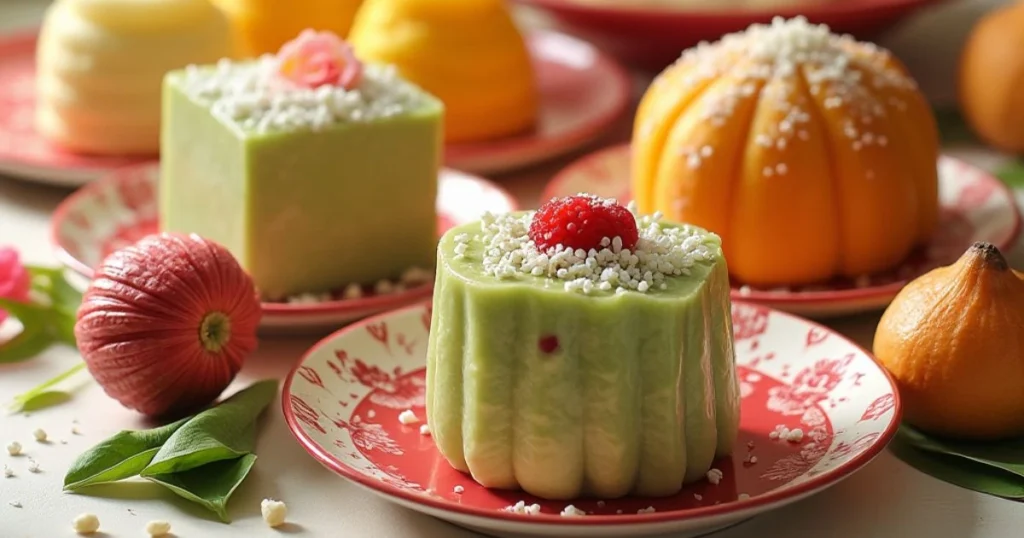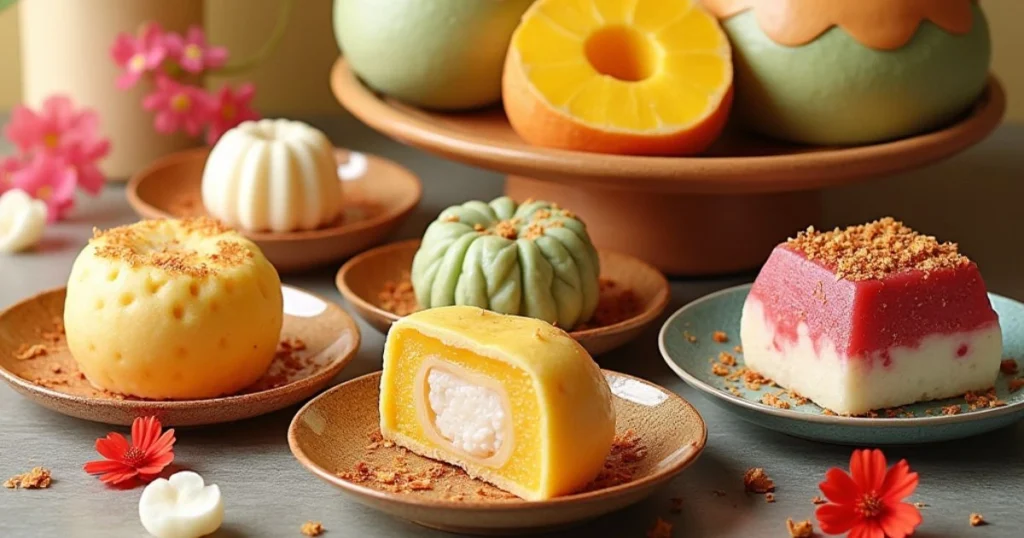Table of Contents
Discover Delicious Asian Desserts: Sweet Treats
I love exploring the world of Asian desserts. From Japan’s soft mochi to Southeast Asia’s fragrant pandan treats, each dessert tells a story. Let’s dive into the flavors and tales of these amazing sweets together.
Key Takeaways
- Discover the rich history and cultural significance behind Asian desserts
- Explore a wide array of exotic and delicious Asian sweets, pastries, and confections
- Learn about the unique flavors and ingredients that make Asian desserts so captivating
- Gain insights into the modern interpretations and creative twists on traditional Asian desserts
- Find inspiration to recreate the flavors of Asia in your own kitchen
Exploring the Vibrant World of Asian Desserts
Dive into the world of Asian desserts, where ancient traditions meet modern twists. Southeast Asia’s fragrant pandan and luscious coconut mix with East Asia’s rich red bean and earthy matcha. These asian dessert flavors will amaze you and take you on a tasty adventure.
Flavors that Delight the Senses
Asian desserts are known for their unique and diverse flavors. Discover the traditional asian desserts like Chinese mooncakes, Japanese wagashi, and Malaysian kuih. These treats impress with their textures and the way their ingredients come together.
A Blend of Ancient Traditions and Modern Twists
The world of modern asian desserts is always changing. Chefs and confectioners are updating classic recipes with new techniques and flavors. See how diverse asian sweets blend with global tastes, creating a mix of asian confectionery and asian pastries. Enjoy the mix of the familiar and the new in these desserts.
“Asian desserts are a delightful exploration of the senses, blending ancient traditions with modern creativity to create a truly captivating experience.”
Popular Thai Desserts to Tantalize Your Taste Buds
Start a journey through the world of Thai desserts. Here, old traditions meet new ideas, creating a mix of tastes. Enjoy the creamy mango sticky rice and the chewy mochi-like delicacies. These sweets show the rich culture of Thailand.
The mango sticky rice is a favorite Thai dessert. It’s sweet, creamy, and a bit salty. The sticky rice and juicy mango make it a taste of Thailand.
Thai sweets also include many other treats. Try the Thai mochi, which is chewy and colorful. It comes in flavors like taro and coconut. These southeast Asian desserts show Thai chefs’ creativity.
Don’t miss the coconut-based treats. They are sweet and salty, with a creamy coconut filling. Each bite is a taste of Thailand’s rich food history.
“Thai desserts are a captivating blend of ancient traditions and modern innovation, inviting you to embark on a flavor odyssey that will leave a lasting impression on your taste buds.”
Enjoying thai desserts and thai sweets is a treat. They mix old ways with new ideas. These thai confections and thai treats show Thai chefs’ skill and love for their culture.
The Allure of Japanese Sweets and Confections
Explore the world of Japanese desserts, sweets, and confections. Here, traditional skills and care turn these treats into art. Enjoy the softness of mochi and the beauty of wagashi (traditional Japanese sweets). These delights not only please your taste buds but also show Japan’s deep culture and love for nature.
From Mochi to Wagashi, a World of Delicate Flavors
Try the perfect mix of flavors in Japanese pastries like red bean paste-filled castella cakes. They are sweet but light. Also, discover mochi, soft rice cakes filled with ice cream or sweet red bean paste. They are key to Japanese dessert culture.
Dive into the world of wagashi, Japan’s traditional sweets. They show Japan’s love for nature and the seasons. These sweets are made with care, looking like flowers or leaves. They are loved for their looks and taste.
| Japanese Dessert | Description |
|---|---|
| Mochi | Soft, chewy rice cakes often filled with ice cream or sweet red bean paste |
| Wagashi | Traditional Japanese confections that resemble delicate natural forms |
| Castella Cake | Spongy, light cakes filled with sweet red bean paste |
Discover the magical world of Japanese sweets and confections. Here, flavors and presentation come together for a unique experience.
Indulging in the Sweet Treats of China
Dive into the magical world of Chinese desserts. Here, ancient recipes meet modern twists. Enjoy the smoothness of silken tofu pudding, the flaky egg tarts, and the chewy mooncakes. These treats have won hearts for ages. Now, Chinese pastry chefs are adding their own flair to these classics.
Traditional Delicacies with a Modern Flair
These chefs respect Chinese sweets while adding new flavors and techniques. Picture a red bean mooncake with a salted egg yolk surprise. Or a mango pudding with a hint of jasmine. The mix of old and new in modern Chinese desserts is truly exciting.
- Discover the delicate balance of traditional and contemporary in Chinese pastries
- Indulge in the rich, velvety textures of Chinese confections
- Explore the diverse array of Chinese treats, from fragrant teas to decadent baked goods
If you love desserts or are new to them, get ready to be amazed. The flavors and artistry of traditional Chinese desserts will take you on a delicious journey. Let your taste buds explore the sweet side of China.
The Irresistible Allure of Asian Desserts
Asian desserts are a feast for the senses. They offer unique flavors, textures, and looks. From Korean honey-dipped rice cakes to Taiwanese shaved ice, they are a world of wonder. Discover why these desserts are loved by many.
The appeal of Asian desserts is in their exotic tastes and traditions. They mix sweet, sour, and savory flavors in a unique way. Ingredients like red bean paste and fragrant floral essences make them special.
These desserts are also a treat for the eyes. Japanese wagashi and Taiwanese shaved ice are stunning. Their beauty and taste make them perfect for both eating and sharing on social media.
| Unique Characteristics of Asian Desserts | Examples |
|---|---|
| Harmonious blend of sweet, sour, and savory flavors | Korean honey-dipped rice cakes, Chinese steamed buns with lotus paste |
| Use of unique ingredients | Red bean paste, sticky rice, fragrant floral essences |
| Visually stunning presentations | Japanese wagashi, Taiwanese shaved ice |
Trying Asian desserts is more than just eating. It’s a journey through rich cultures and art. Whether you like Japanese or Thai sweets, there’s something for everyone. It’s a way to explore new tastes and enjoy the beauty of these desserts.
Bringing the Flavors of Asian Desserts to Your Home
Want to make Asian desserts at home? You’re in the right place! This section will teach you how to make Asian-inspired desserts. You’ll feel like you’re in Asia with every bite.

Recipes and Tips for Delicious Homemade Treats
Find a wealth of Asian dessert recipes and tips here. Learn about the key Asian dessert ingredients and techniques. You’ll soon impress everyone with your new dessert skills.
- Start with classic Asian dessert recipes like mochi, matcha green tea cake, or sticky rice with mango.
- Try unique Asian dessert ingredients like red bean paste, adzuki beans, or pandan leaves. They add depth and complexity.
- Tip: Invest in essential tools like a bamboo steamer or a rice cooker. They make the process easier and more authentic.
- Don’t be afraid to add your own twist to traditional Asian desserts. Mix in modern flavors and presentation.
With practice and these tips for making Asian desserts, you’ll soon make Asian desserts like a pro. Get ready to amaze your taste buds and impress your guests with your homemade Asian treats.
Discovering the Health Benefits of Asian Desserts
Many healthy asian desserts have surprising health benefits. They are not just tasty but also packed with nutrients. Ingredients like chia seeds, red beans, and adzuki beans are full of vitamins, minerals, and antioxidants.
These desserts are a healthier choice than many Western sweets. They offer a mix of essential nutrients. Learn how to add them to your diet for a tasty and healthy treat.
Unlocking the Nutritional Value of Asian Desserts
The nutritional value of asian desserts is often overlooked. Yet, they can be a great addition to your diet. Chia seeds, for example, are rich in fiber, protein, and omega-3s. They make a nutritious alternative to sugary sweets.
- Adzuki beans, found in mochi and red bean desserts, are full of antioxidants, fiber, and minerals.
- Red beans, used in Chinese and Japanese sweets, offer plant-based protein, complex carbs, and B vitamins.
- Coconut milk, common in Southeast Asian desserts, is rich in healthy fats. It supports heart health.
Exploring healthy asian desserts lets you enjoy sweet treats that are good for you. They not only taste great but also provide health benefits. Add them to your diet for a nutritious and satisfying experience.
Cultural Significance and Symbolism in Asian Desserts
Asian desserts are more than just tasty treats. They carry deep cultural meaning and symbolism. For example, moon cakes in China symbolize family unity during the Mid-Autumn Festival. In Japan, mochi is given to celebrate the new year, showing the joy of new beginnings.

These desserts are not just about taste. They shape traditions and beliefs passed down through generations. The designs and ingredients in these sweets often mean prosperity, longevity, and good fortune. Learning about their history and symbolism helps us appreciate the rich heritage of Asian culinary customs.
Sweet Treats with a Rich Heritage
Asian desserts have kept their cultural ties through time, mixing old traditions with new ideas. Enjoying wagashi from Japan or pandan-infused sweets from Southeast Asia opens a world of flavors. These desserts celebrate the diversity and heritage of the region.
By understanding the symbolism and significance of these sweets, we gain a deeper insight into the vibrant cultures that created them. It’s a journey into the heart of Asian traditions and values.
FAQ
What are the unique flavors and ingredients used in Asian desserts?
Asian desserts are known for their special ingredients. You’ll find pandan, coconut, red bean, and matcha. These flavors mix old traditions with new twists, creating a unique taste experience.
How do traditional Asian desserts differ from their modern counterparts?
Today’s Asian desserts mix old recipes with new ideas. They blend traditional flavors with global tastes and creative ways of serving. This mix celebrates both the old and the new.
What are some popular Thai desserts that you can try?
Thai desserts are a treat. Try mango sticky rice for its creamy taste. Or, enjoy chewy mochi-like sweets and coconut-based treats for a sweet and salty mix.
What are the unique characteristics of Japanese sweets and confections?
Japanese sweets, or wagashi, are known for their delicate taste and beautiful art. Try mochi for its softness and red bean paste-filled castella cakes for their unique flavors.
How are traditional Chinese desserts being reinvented with a modern twist?
Modern Chinese pastry chefs are updating old favorites. They add new twists to classics like silken tofu pudding and egg tarts. This keeps the cultural heritage alive while introducing new flavors.
What makes Asian desserts so appealing and unique?
Asian desserts are a feast for the senses. They offer a mix of flavors, textures, and looks. These sweets celebrate the East’s rich culture and have won fans worldwide.
How can I recreate the flavors of Asian desserts at home?
Want to make Asian desserts at home? There are many recipes and tips to help. Learn about key ingredients, techniques, and how to mix flavors for a taste of the East.
Are Asian desserts healthy?
Yes, many Asian dessert are healthy. They use ingredients like chia seeds and red beans. Discover how these sweets can be part of a healthy diet.
What is the cultural significance and symbolism behind Asian dessert?
Asian dessert hold deep cultural meaning. They reflect the region’s traditions and heritage. From moon cakes in China to Japanese mochi, these sweets offer a glimpse into Asian cultures.

